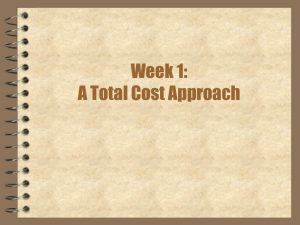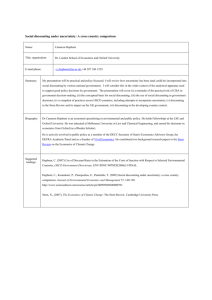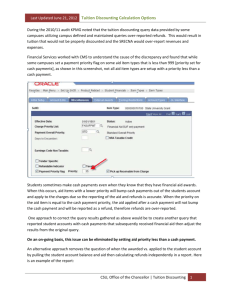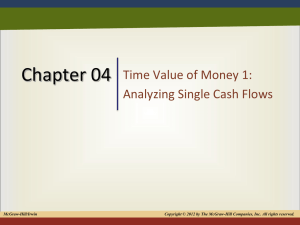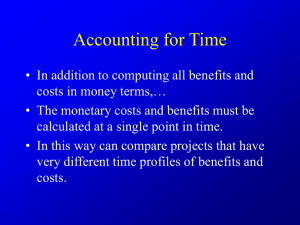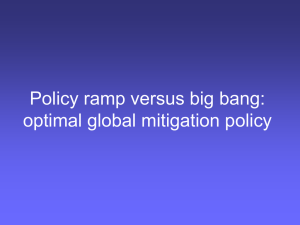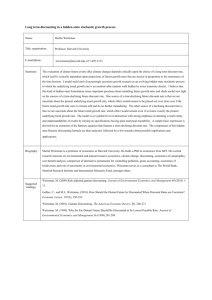RUNNING HEAD: Temporal Discounting
advertisement
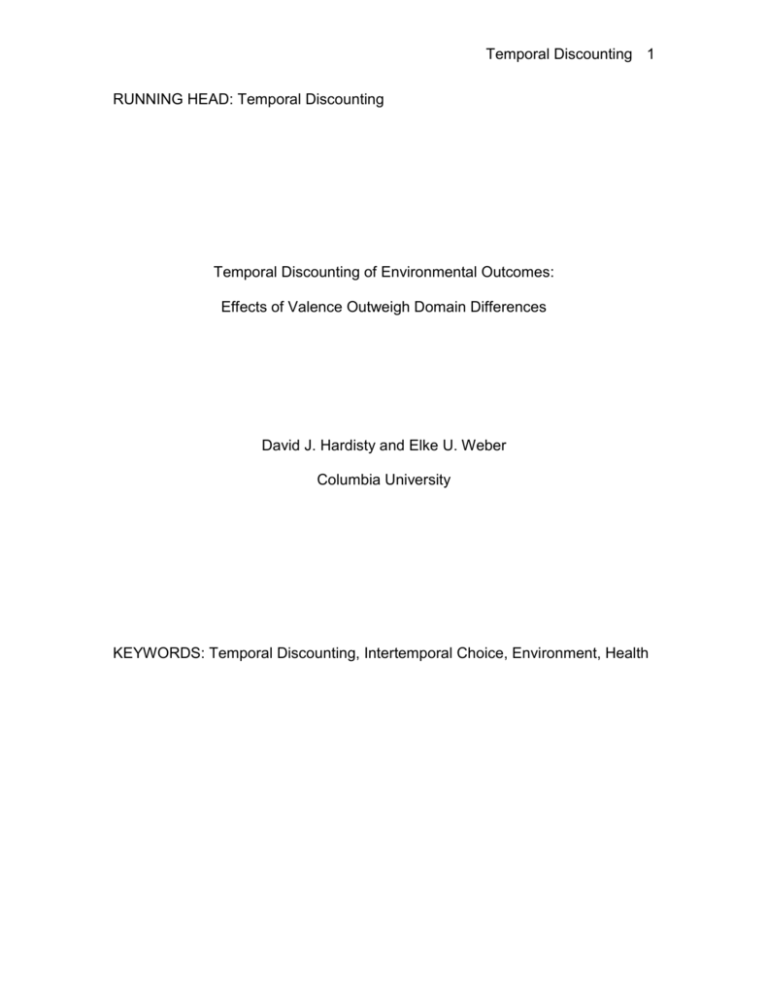
Temporal Discounting 1 RUNNING HEAD: Temporal Discounting Temporal Discounting of Environmental Outcomes: Effects of Valence Outweigh Domain Differences David J. Hardisty and Elke U. Weber Columbia University KEYWORDS: Temporal Discounting, Intertemporal Choice, Environment, Health Temporal Discounting 2 Abstract In two studies, participants (N=183) made choices between hypothetical financial, environmental, and health gains and losses that took effect either immediately or with a 1-year delay. In all three domains, choices indicated that gains were discounted more than losses. While there were no significant differences between discounting of monetary and environmental outcomes, health gains were discounted more and health losses were discounted less than gains or losses in other domains. Correlations between implicit discount rates for these different choices suggest that discount rates are influenced more by the valence of outcomes (gains vs. losses) than by domain (money, environment, or health). Overall, results indicate that when controlling as many factors as possible, at short delays, environmental outcomes are discounted in a similar way to financial outcomes. Temporal Discounting 3 Temporal Discounting of Environmental Outcomes: Effects of Valence Outweigh Domain Differences Understanding the factors that affect the discounting of future outcomes is critical for individual and policy decisions involving long time horizons. At the individual level, prudent pension investment choices are often inhibited by temporal myopia (Thaler & Benartzi, 2004). At a policy level, leading economists assert that "the biggest uncertainty of all in the economics of climate change is the uncertainty about which interest rate to use for discounting" (Weitzman, 2007). While much of this debate has evolved around the philosophical and ethical issues that might dictate what discount rate(s) should be used to make cost-benefit calculations for different courses of action in such policy contexts, behavioral research on the discount rate implicit in people’s intertemporal decisions is also very informative. Contrary to rational economic models of (exponential) discounting, that always apply the same discount rate (per unit of delay) to outcomes that are not immediately realized, several robust "irrational" phenomena have been documented in descriptive studies of the discounting of future outcomes (for a review, see Frederick et al., 2002): people discount at a relatively greater rate (per unit of time) when considering short delays than when considering longer ones (this known as "hyperbolic discounting" or "temporal myopia," Mazur, 1987), people discount gains more than losses (the "sign effect", Thaler, 1981), discount large outcomes less than small ones (the "magnitude effect," Thaler, 1981), and discount more when the default is to receive something now than when the Temporal Discounting 4 default is to receive it later (the "accelerate-delay" asymmetry, Loewenstein, 1988; Weber et al., 2007). They also prefer improving sequences to declining ones with the same average (Hsee et al., 1991; Loewenstein & Sicherman, 1991), and prefer to spread positive experiences out over time rather than experience them all immediately (Loewenstein & Prelec, 1993). One variable whose effect on discounting has not been examined with the same level of attention is the outcome domain, e.g., whether it is a delayed financial outcome (receipt of a $1000 lottery win in a year’s time) or environmental outcome (better air quality in a year’s time). Rational-economic models assume explicitly and many behavioral models assume implicitly that while discount rates may vary between individuals, reflecting their differing time preferences, a given individual should and does use the same discount rate for future outcomes in different domains. A parallel can be drawn from intertemporal choice to risky choice, where the dominant rational-economic assumption continues to be that risk attitude (i.e., the discounting of an outcome as a function of how likely or unlikely it is expected to occur) can vary between individuals, but that a given individual should exhibit the same level of risk aversion to outcomes in all domains. Contrary to that assumption, however, it has become well established empirically that the risk attitudes of individuals differ quite strongly across different domains (Weber et al., 2002). In the small number of studies that have examined temporal discounting studies for outcomes other than in the financial domain (contrasting them to health outcomes), domain dependencies of various sorts have also been reported (Chapman, 1996a; b; 2003). Recent Temporal Discounting 5 theoretical developments also suggest that different goals (e,g., financial vs. social, vs. environmental goals) may be discounted at different rates (Krantz & Kunreuther, 2007). The research in this paper on the discounting of environmental outcomes was thus motivated by a combination of theoretical and policy-oriented considerations. A few previous studies examined the discounting of environmental outcomes and made comparisons to the discounting of financial outcomes, but did not control for possible confounding factors. For example, Bohm & Pfister (2005) report data suggesting that temporal discounting is lower for environmental outcomes. Their scenarios presented participants with potential environmental losses to be incurred by others, whereas the typical financial discounting study presents participants with monetary gains that are available to the participant him/herself. The low discount rates observed may thus have been due to the difference in valence (as gains are typically discounted more than losses, Thaler, 1981) or the difference who was affected by the consequences (others vs. self). Similarly, in a brief review of temporal discounting studies, Gattig & Hendrickx (2007) conclude that discounting is less pronounced for environmental risks than for other domains, noting that a substantial proportion of participants (in the range of 30% to 50%) do not discount environmental risks at all. However, none of the papers reviewed directly compare monetary and environmental outcomes nor do they control for confounding factors such as the valence of outcomes. Temporal Discounting 6 To the best of our knowledge, only one empirical study has directly compared intertemporal preferences for monetary and environmental outcomes. Guyse and colleagues (2002) presented graduate business school students with various sequences of income, air quality, water quality, and health (all graphically represented, of equivalent expected value). Participants preferred increasing sequences for everything except income, thus demonstrating domain differences in intertemporal preferences for monetary and environmental outcomes. However, the results of this study may be difficult to generalize to the general population because, as the authors note, graduate business students are trained in net present value computations and thus know the "right" answer for monetary sequences is to prefer the decreasing profile (with the highest initial payout). This is a plausible alternative explanation in light of the fact that other studies have found that participants typically prefer increasing profiles in the financial domain as well (Hsee et al., 1991; Loewenstein & Sicherman, 1991; Schmitt & Kemper, 1996). Given the lack of research directly comparing discounting of monetary and environmental outcomes, one may look to discounting of other non-monetary domains, such as health, for evidence that nonmonetary dimensions like environmental outcomes may be discounted differently. Based on a series of studies, Chapman (2003) concluded that although on average, across respondents and conditions, mean discount rates for money and health outcomes were similar, and the same contextual factors known to influence financial discount rates (length of delay, and magnitude and valence of Temporal Discounting 7 outcomes) also affected the discount rates for health outcomes (Chapman & Elstein, 1995; Chapman, 1996a; b)., discount rates were, in fact, domain dependent. In particular, she found that correlations of discount rates within a domain (roughly .6 to .8) were typically higher than correlations of discount rates between domains (.1 to .4). In other words, if someone steeply discounted a small financial gain delayed by one year, that person was likely to discount other financial gains (of different amounts, at different delays) relatively steeply as well. In contrast, this same person might discount health outcomes much less steeply, while the opposite pattern could be true for someone else. We used these results to provide us with hypotheses about the discounting of environmental outcomes. Thus we expected the same factors known to affect financial and heath discounting to also affect the discounting of environmental outcomes and to potentially find domain-specific discounting. To test these predictions, it was necessary to control for the multiple factors that typically distinguish intertemporal decisions involving environmental outcomes from those involving monetary outcomes. Specifically, environmental outcomes typically affect multiple people (rather than only the decision-maker), on a longer time-scale (sometimes exceeding the lifetime of the decision maker), and are often less familiar and more ambiguous than typical monetary outcomes. Furthermore, environmental outcomes often result in semi-permanent changes in the state of the world (changes in what economists would call streams of consumption) rather than a one-time consumption event. In other words, as typically studied in laboratory studies, the utility from receiving a monetary reward Temporal Discounting 8 is assumed to be experienced at one point in time, whereas the utility from an environmental outcome such as an improvement in water quality or the extinction of a species is often experienced over a long period of time. The present research endeavored to test for domain differences while controlling for these confounding factors as much as possible. While the values of environmental goods are often measured (and the implicit discount rate inferred) by "pricing them out" through contingent valuation (Mitchell & Carson, 1989), which relies on the perception of respondents that environmental outcomes can be easily valued in and exchanged for dollars (and vice versa), this may not be a valid assumption (Gregory et al., 1993; Schkade & Payne, 1994; Frederick, 2006). For example, when asked to assign a monetary value (e.g., their willingness-to-pay) to some environmental consequence, respondents often express the strength of their attitudes (protecting the environment is important), or express what they consider a fair contribution, rather than communicating the result of a cost/benefit analysis reflecting the magnitude and value of the environmental outcome (Schkade & Payne, 1994). Thus, discount rates assessed through contingent valuation may be very misleading. In contrast, and following the methodology of the health outcome discounting literature, the studies presented below assessed discount rates using within domain measures. In the first study, we compared discounting of monetary gains and losses with discounting of four environmental scenarios: air quality gains, air quality losses, mass transit gains, and garbage pileups (a loss). Choices in all cases involved an immediate option and an option with a one-year time delay. Efforts Temporal Discounting 9 were made to control for commonly confounding factors, including timescale, uncertainty, who was affected, and one-time consumption vs. a change in consumption streams. Based on theory that different goals may be discounted at different rates (Krantz & Kunreuther, 2007), we predicted that discounting for environmental outcomes might very well differ from those for those for financial outcomes. Although we did not have strong reasons to predict the direction of the difference, we hypothesized that environmental outcomes would be discounted less on average than monetary outcomes, based on the findings and conjectures of previous studies of environmental outcomes (Svenson & Karlsson, 1989; Nicolaij & Hendrickx, 2003; Gattig & Hendrickx, 2007). We also hypothesized that withindomain discount rates would be more highly correlated than between-domain discount rates, based on Chapman's domain dependence theory and findings (Chapman & Elstein, 1995; Chapman, 1996a; b; Chapman et al., 1999; Chapman, 2003). Study 1: Method Participants 90 participants were recruited online via classified ads for a study on decision making, and were compensated $8 for their participation. Data from 6 participants who did not complete the study was excluded, as was data from 3 participants who completed the study in less than 10 minutes (mean completion time was 31 minutes). Finally, data from 16 participants was excluded for not satisfying other careful-response criteria. Using these criteria, participants were Temporal Discounting 10 excluded if their answers to the titration items (described below) switched back and forth more than once, or switched in a manner that would only make sense if they preferred more losses or less gains (ie, preferring $150 now to $250 in one year yet also preferring $230 in one year to $150 now). All further analyses concern the 65 remaining participants.1 Participants were 66% female, with an average age of 31 (SD = 9.2). 52% were married, and 54% had children. 27% were students, 62% had a college degree of some kind, and the median household income was $35,000 - $49,999. Procedure After answering questions for an unrelated study, participants responded to four hypothetical scenarios: two monetary (one gain, one loss), and two environmental (one gain, one loss), in counterbalanced order. For the environmental scenarios, participants were randomly assigned to complete either two air quality scenarios (gain and loss) or a mass transit improvement (gain) scenario and garbage pile-up (loss) scenario. Finally, participants provided demographic details. Scenarios Monetary Gain: Participants read the text, "Imagine you just won a lottery, worth $250, which will be paid to you immediately. However, the lottery commission is giving you the option of receiving a different amount, paid to you one year from now." They then answered 10 binary choice questions, where they chose between winning $250 immediately or winning $410 (or $390, or $370, etc) one year in the future. This titration procedure was used to elicit the point at Temporal Discounting 11 which participants were indifferent between present and future gains. For this and all other titration measures, the scale went from roughly 1.6 to .9 times the present value (for example, $410 to $230). Following the titration, participants answered the following question: "Please fill in the number that would make you indifferent between the following two options: A. Win $250 immediately. B. Win $___ one year from now." A single indifference point for each participant was obtained from titration using the point at which he or she switched from preferring the future option to preferring the present option, unless the participant maxed out the titration scale, in which case the free response measure was used. Monetary Loss: Participants were told to imagine they got a parking fine which they could pay immediately or one year in the future. Similar titration and free response questions were used to determine the indifference point between immediate and future payment. Air Gain & Loss: Participants were told to imagine the local county government was considering a temporary change to its emissions policy to study the effects of air quality on human health and the local wildlife. The particulate output of nearby factories and power plants would be immediately reduced [increased] for a period of three weeks, after which time the air quality would return to its former level, but the government was also considering making the change one year in the future, for a different length of time. Titration and free response items were used as before, with choices such as "Improved air quality immediately for 21 days, or improved air quality one year from now for 35 days." Participants were asked to consider only their personal preference (for improved Temporal Discounting 12 [worse] air quality immediately or in the future) as they made their choices. Subsequently, to get a sense of how much they valued the air quality relative to the money, participants were asked whether they would choose to gain [lose] $250 or would choose improved [worse] air quality for 21 days. Mass Transit (gain): Participants were told to imagine the local transit authority had a temporary budget surplus which they were required to spend in the next 18 months, which would be used to improve the frequency, hours, and cleanliness of buses, trains, and subways. Furthermore, as more people would be expected to use mass transit, traffic congestion would also be reduced, benefiting those who drive cars or bicycles. The transit authority planned to implement the improvement immediately for 60 days, but was also considering doing it one year in the future for a different length of time. Participants responded to titration and free response items as before, and were again asked to consider only their personal preference. Subsequently, participants chose between receiving $250 immediately or having improved transit immediately for 60 days. Garbage Pile-Up (loss): Participants were told to imagine the local sanitation workers union was planning to strike, which would lead to garbage and litter piling up on the streets and a bad smell. The union was planning to strike immediately for 21 days but was also considering striking one year in the future, for a different length of time. As before, titration and free response measures were used and participants were asked to consider only their personal Temporal Discounting 13 preference. Subsequently, participants chose between paying $250 immediately or having garbage in the streets for 21 days. Study 1: Results As described above, a combination of titration and free response measures were used to obtain a single indifference point for each scenario. To enable comparisons between scenarios and domains, these indifference points were converted to discount parameters using the hyperbolic discounting formula V = A / (1+kT) (Mazur, 1987), where V is the outcome amount obtainable at present (ie $250), A is the outcome amount obtainable at the specified future time point (ie $400), and T is the delay in time between now and the specified future time point, typically in years (ie 1 year). This equation can be solved for k, the discount parameter that indicates how much someone values future outcomes relative to present outcomes. A k of zero means the present and future are valued equally. Positive values of k indicate that future outcomes are discounted (the more so, the larger k), meaning that decision maker prefers to receive gains now rather than later, or prefers to receive losses later rather than now. Negative values of k, on the other hand, indicate negative discounting, meaning that the decision maker prefers to receive gains later rather than now, or prefers to receive losses now rather than later. We chose this hyperbolic model because of its simplicity, considerable descriptive support (Mazur, 1987; Kirby & Marakovic, 1995; Myerson & Green, 1995; Kirby, 1997; Frederick et al., 2002), and equal treatment of positive and negative discounting (unlike an Temporal Discounting 14 exponential discounted utility transformation, which minimizes extreme positive discounting but magnifies extreme negative discounting). Mean discount parameters for each of the 6 scenarios are summarized in Figure 1. The smaller standard error bars in Figure 1 for the monetary scenarios partly reflect the fact that the number of observations (n = 65) is twice as large as for the air quality (n = 31) and other environmental (n = 34) scenarios. Participants discounted monetary gains, k = 0.35 (SD = 0.32), more than losses, k = 0.06 (SD = 0.17), a significant difference, t(64)=6.0, p < .001, corresponding to a large effect size, d = 4.6. In more concrete terms, participants were indifferent on average between getting $250 now or getting $337.50 in one year, and were indifferent between losing $250 now or losing $265 in one year. Similarly, participants discounted air quality gains, k = 0.45 (SD = 0.56), more than losses, k = 0.08 (SD = 0.29), t(30)=3.7, p = .001, and discounted mass transit improvement, k = 0.49 (SD = 0.95), more than garbage pile-ups, k = .09 (SD = 0.43), t(33)=2.4, p < .05. Although no significant differences were found in pair-wise comparisons of gains or losses between domains, the large standard deviations and low sample sizes meant that we only had sufficient power (.80) to detect fairly large differences (d = 1.2 or larger), so we could neither reject the null hypothesis nor conclude that there weren't any meaningful differences between domains. A 2 (valence: positive or negative) x 2 (domain: monetary vs environmental) repeated-measures ANOVA confirmed the main effect of valence, F(1,64) = 28.3, p < .001, but not domain, F(1,64) = 2.2, p = .14, or the interaction, Temporal Discounting 15 F(1,64) = 1.2, p = .27. Entering order effects into the model revealed that although the order of presentation of domain had no effect, participants discounted significantly more (for both domains and for gains and losses) when gains were presented first, F(1,63) = 7.5, p < .01. Entering age as a covariate, an (unpredicted) age by valence interaction indicated that older individuals responded to valence more strongly, discounting gains more and losses less, F(1,63) = 9.07, p < .01. Gender, marital status, number of children, education, occupation, and income each had no significant effect. For comparison with previous studies which reported high rates of nondiscounting for environmental scenarios, we computed the proportion of zero or negative discounting in each domain. While few individuals exhibited zero or negative discounting for monetary (.00), air quality (.03), or mass transit (.06) gains, a substantial proportion displayed this pattern of preferences for monetary (.28), air quality (.35), and garbage (.35) losses. While differences between proportions for gains and losses were significant (all pair-wise comparisons significant at p < .01 or better), there were no (within-valence) differences between domains. Discounting of monetary gains was correlated with discounting of air quality gains, r = .68, p < .001, and transit gains, r = .45, p < .01, while discounting of monetary losses was correlated with discounting of air quality losses, r = .38, p < .05, and garbage pile-ups, r = .41, p < .05. Note that discounting of air quality could not be correlated with discounting of transit and garbage, as this was a between-subjects manipulation. Discount rates for gains Temporal Discounting 16 and losses within each domain were not significantly correlated. Finally, although not predicted, discounting of monetary gains was correlated with discounting of garbage pile-ups, r = .45, p < .01. Only 10% of participants said they would prefer the immediate improved air quality for 21 days over receiving $250, while 42% said they would rather pay $250 than have worse air quality for 21 days. Similarly, 15% reported preferring 60 days of improved mass transit to the $250, and 35% said they would rather pay the $250 rather than have 21 days of garbage in the streets. These differences in choice proportions suggest that the degree of loss aversion (i.e., the observation that losses of a given magnitude hurt more than gains of the same magnitude provide pleasure) described by prospect theory (Tversky & Kahneman, 1992) was, in fact, stronger for the environmental outcomes than for financial outcomes (the gain or payment of $250), consistent with other studies (Novemsky & Kahneman, 2005). Study 1: Discussion When presented with monetary and environmental gain and loss scenarios which were written to control as many factors as possible, participants discounted gains substantially more than losses but did not discount environmental outcomes significantly more or less than monetary outcomes. The valence difference was stronger between subjects; participants who were presented with gains first tended to discount all outcomes more overall, likely exhibiting greater discounting for gains and then endeavoring to remain somewhat consistent in their responses to other scenarios. Temporal Discounting 17 Similar to previous studies on discounting of environmental losses, a substantial number of participants exhibited zero or negative discounting of environmental losses. However, a similar proportion of participants showed this preference for monetary losses, thus suggesting that the pattern of results observed in previous studies may have been due more to the valence of the outcomes than the domain. Reinforcing this perspective, very few participants displayed zero or negative discounting of environmental gains. Recall that for losses, negative discounting implies that a participant would rather experience a larger, sooner loss than a smaller, later loss. One motivation for this preference could be disutility from anticipation -- in other words, participants would prefer to experience the negative event immediately (and thus get it over with) rather than dread its future arrival (Loewenstein, 1987). As in previous studies, discounting was moderately correlated between domains. This means that knowing how much someone valued future monetary gains relative to immediate monetary gains allows one to predict how much that participant valued future environmental gains relative to immediate environmental gains. However, correlations between discounting of gains and losses were quite low, so knowing how much someone discounted environmental gains tells little about how much they discounted environmental losses. In summary, the correlation data suggest that at both the individual subject level and averaged across subjects, discounting is influenced quite strongly by the valence of outcomes and not so much by their domain. Temporal Discounting 18 While the lack of significant differences between environmental and monetary domains was somewhat surprising, null results are always difficult to interpret. We therefore ran a second study, with several objectives. Most importantly, we wanted to see if our null results with respect to domain differences would replicate with greater statistical power. One way of demonstrating such power was to replicate other domain differences previously demonstrated in prior research. In Study 2, we therefore compared the discounting of monetary and environmental outcomes with the discounting of health outcomes. Previous research has demonstrated that at short delays (1 year or less) health gains are discounted more than monetary gains (Chapman & Elstein, 1995; Chapman, 1996b; Chapman et al., 1999) while health losses are discounted less than monetary losses (Chapman, 1996b).2 The second objective of Study 2 was to establish whether the lack of difference in discounting between monetary and environmental outcomes observed in Study 1 was due to idiosyncrasies of the (fairly abstract) scenarios employed or was a more general effect. Towards this end, we designed new air quality scenarios, using a standard, real world measure of air quality, and we recruited participants from areas with poor air quality. Through these measures, we hoped to generalize the results of Study 1 to an environmental scenario that might be more realistic to knowledgeable participants. Finally, the third objective of Study 2 was to explore the role of individual differences in predicting discounting of environmental outcomes. Based on previous research demonstrating that scores on the Cognitive Reflection Test , Temporal Discounting 19 described below, predict discounting of monetary gains but not of positive or negative health events such as getting a massage or submitting to dental work (Frederick, 2005), we administered the three-item test to participants to see whether it would predict discounting of monetary and environmental gains but not of health outcomes. Study 2: Method Participants 167 participants were recruited from the 10 ZIP-codes in the country with the worst average air quality (as measured by the AQI, explained below in Scenarios); these were mainly from California and Arizona. Participants were recruited and paid in the same manner as Study 1. Using the same criteria as Study 1, data were dropped from 6 non-completers, 6 who completed the study in less than 10 minutes (mean completion time was 38 minutes), and 37 participants who failed our careful-response criteria, leaving 118 participants for analysis. Participants were 55% female, with an average age of 38 (SD = 13). 49% were married, and 50% had children. 13% were students, 85% had a college degree of some kind, and the median household income was $50,000 - $99,999. 75% of participants indicated they had heard of the AQI prior to the study, but only 40% were familiar with it. 97% of participants indicated they had experienced changes in air quality. Temporal Discounting 20 Procedure All participants responded to 6 scenarios: monetary gain & loss, air quality gain & loss, and health gain & loss. Order was partially counterbalanced, such that the three scenarios in each valence (gain or loss) were always presented together, with the gain scenarios appearing first half the time. While the ordering of the air and health scenarios was balanced (appearing either first or third), the monetary scenario was always presented second in each group. After the scenarios, participants answered questions about their experience with each domain, answered demographic questions, and completed the three-item Cognitive Reflection Test (Frederick, 2005). The CRT measures cognitive ability and, in particular, the ability to inhibit fast but inaccurate answers to questions such as "A bat and a ball cost $1.10. The bat costs $1.00 more than the ball. How much does the ball cost? ___ cents." Scenarios Monetary Gain & Loss: Although the basic scenarios were the same as those used in Study 1, the ordering and formatting of the titration options were changed to a format that seemed more natural. Also, the free response questions asked participants to "fill in the number that makes the following two options equally [un]attractive" rather than using the Study 1 language "fill in the number that would make you indifferent between the following two options," because several participants in Study 1 mentioned being confused by the reference to "indifference." Temporal Discounting 21 Air Gain & Loss: Although the air quality cover stories were similar to those used in Study 1, the dependant variable was different. The Air Quality Index (AQI), a 0 to 500 continuous air quality measure employed by the U. S. Environmental Protection Agency (2003), was used to specify different gradations of improvement or deterioration in air quality. AQI forecasts are reported in the weather sections of newspapers in polluted areas (such as the LA Times), so it was plausible that participants would already be familiar with it. Before the first air quality scenario, a one page explanation of the AQI was presented to all participants. In the loss scenario, participants were told to imagine that the local AQI average was 90 (in the "moderate" range -- note that higher numbers signify more pollutants), and a temporary emissions policy change would worsen air quality either immediately or one year in the future. Titration and free response measures were again used, with choices such as "40 point deterioration in air quality, starting immediately, or 64 point deterioration in air quality, starting 1 year from now." In the gain scenario, participants were told to imagine the local AQI average was 130, and air quality would be improved by 40 points (or a different amount in one year). As the best possible AQI value is 0, the maximum possible improvement was therefore 130, so participants' indifference points for gains (and hence discount rates) had a ceiling. As in Study 1, participants were also asked to choose between gaining [losing] $250 and better [worse] air quality for 3 weeks. Health Gain: In a scenario adapted from Chapman (1996b), participants were told to imagine they were in poor health and could choose between two Temporal Discounting 22 treatments, one of which would take effect immediately and result in health improvements for a specified length of time or another which would take effect one year in the future and last a different (generally longer) amount of time. Although Chapman (Chapman, 1996b) used health improvements lasting 1 to 8 years, we used health improvements lasting around 12 weeks, based on pretesting indicating that these would be valued more closely to the outcomes in the monetary and air quality scenarios. Again, titration and free response measures were used to assess indifference points between immediate and later choice options and to infer the discount parameter k. As with the other scenarios, participants also chose between gaining $250 and having improved health for 12 weeks. Health Loss: In this scenario, also adapted from Chapman (1996b), participants were told to imagine they were in full health and could choose between two diseases, one of which would take effect immediately and last for 12 weeks and the other which would take effect in one year but last longer. Questions and amounts were equivalent to those used for the health gain scenario. Study 2: Results As mentioned above, the air quality gain scenario used only allowed for a maximum discount parameter of k = 2.25 (equivalent to a one-year discount rate of 69%). To fairly compare discounting across scenarios and domains, we therefore capped all discount parameters at 2.25 or -2.25. In other words, any Temporal Discounting 23 score beyond that range was set to 2.25 or -2.25, as appropriate. 6% of scores were capped in this way. Mean discount parameters for each of the 6 scenarios are shown in Figure 2. As in Study 1, gains were discounted significantly more than losses, with all gain/loss t-tests highly significant and effect sizes of d = 1.6 to 2.0. Also as in Study 1, air quality gains were not discounted significantly differently from monetary gains (although there was a trend for monetary gains to be discounted more), nor were air losses discounted significantly differently from monetary losses. In contrast, health gains, k = 0.77 (SD = 0.88), were discounted significantly more than monetary gains k = 0.58 (SD = 0.77), t(117) = 2.1, p < .05, and air quality gains k = 0.45 (SD = 0.52), t(117) = 4.0, p < .001. Furthermore, health losses, k = -0.01 (SD = 0.44), were discounted less than monetary losses, k = 0.07 (SD = 0.23), t(117) = 2.1, p < .05, and air quality losses, k = 0.13 (SD = 0.37), t(117) = 2.9, p < .01. However, these differences were only modest, with effect sizes ranging from d = 0.2 to 0.5, i.e., substantially smaller than effect sizes for outcome valence. Although not predicted, discount rates for monetary gains were significantly higher in Study 2 than in Study 1, t(170) = 2.9, p < .01. In more concrete terms, on average participants were indifferent between gaining $250 immediately or $395 in one year, losing $250 immediately or losing $267.5 in one year, a 40 point improvement in air quality immediately or 58 points in one year, a 40 point deterioration in air quality immediately or 45.2 points in one year, 12 weeks of improved Temporal Discounting 24 health immediately or 21.2 in one year, and 12 weeks of worse health immediately or 11.9 in one year. A 2 (valence: positive or negative) x 3 (domain: monetary vs air quality vs. health) repeated-measures ANOVA confirmed the main effect of valence, F(1,117)=114.4, p < .001, indicating that gains were discounted more than losses, and the valence by domain interaction, F(2,116)=12.7, p < .001, indicating that the effect of valence was greater for health outcomes. Upon entering order effects into the model, participants discounted significantly more when gains were presented first, F(1,111)=18.0, p < .001, as in Study 1. Entering age as a covariate, the valence by age interaction (observed in Study 1) was not significant, F(1,114) = 1.7, p = .19, but trended in the same direction. Gender, marital status, number of children, education, occupation, and income each had no significant effect. CRT data was missing from 3 participants due to a technical error. Entering the CRT as a covariate in the ANOVA revealed a main effect of CRT, F(1,113) = 5.0, p < .05, indicating that individuals who scored higher discounted less, and a CRT by valence interaction, F(1,113) = 5.7, p < .05, indicating that while higher CRT scores were associated with less discounting of gains, there was no relationship between CRT and discounting of losses. While simple GLMs confirmed the power of CRT to predict discounting of monetary gains, F(1,114) = 4.8, p < .05, no relationship was found between CRT and health gains, F(1,114) Temporal Discounting 25 = 0.4, p = .51, or between CRT and losses in any domain, all p > .2, thus replicating prior research (Frederick, 2005). Also, the CRT predicted air quality gains, F(1,114) = 12.7, p < .01. Similar to Study 1, only a small proportion of individuals exhibited zero or negative discounting for monetary (.03), air quality (.10), or health transit (.07) gains, while a substantial proportion displayed this pattern of preferences for monetary (.29), air quality (.25), and health (.43) losses. Differences in these proportions between gains and losses were all significant at p < .01 or better. Also, zero or negative discounting occurred more often in response to the health loss scenario than the monetary loss, p < .05, or air loss scenarios, p < .01. Correlations between discount rates were similar, though somewhat lower than those in Study 1. Discounting of monetary gains was correlated with health gains, r = .35, p < .001, and discounting of air gains, r = .26, p < .01. Likewise, discounting of monetary losses was correlated with discounting of health losses, r = .39, p < .001, but non-significantly correlated with discounting of air losses, r = .10, p = .27. Discounting of health gains was correlated with discounting of air gains, r = .35, p < .001, but health losses were not significantly correlated with air losses, r = .08, p = .39. Within domain correlations were weak. Monetary gains were not correlated with monetary losses, r = .05, p = .57, and health gains were not correlated with health losses, r = .09, p = .32, while air gains were moderately correlated with air losses, r = .29, p < .01. While not predicted, health gains were weakly correlated with air losses, r = .22, p < .05. Temporal Discounting 26 Just as 65% of participants preferred improved air quality for 3 weeks over receiving $250, so too 63% preferred paying $250 over 3 weeks of worse air quality. 88% of participants preferred 12 weeks of improved health to $250, while 92% preferred paying $250 to 12 weeks of worse health. Thus, different from Study 1, the non-monetary outcomes of the environmental scenarios used in this study were valued more highly than the monetary outcomes of the financial scenarios. Study 2: Discussion A sample of respondents living in areas with poor air quality indicated intertemporal preferences for hypothetical monetary, air quality and health scenarios which were written to control for as many factors as possible. Replicating the results of Study 1, mean discount rates did not differ significantly between air quality and monetary outcomes. At the same time, we replicated previous results by showing that at one-year delays health gains were discounted more than gains in money or air quality while health losses were discounted less than losses in money or air quality. This suggests that participants were indeed sensitive to the domain, giving us more confidence in the null results observed in both studies. Further supporting the idea that money and air quality are discounted in similar ways (but different from the way health is discounted) was the fact that the CRT predicted discounting of monetary and air quality gains but not discounting of health gains. As in Study 1, gains were discounted much more than losses in all domains, with a substantial proportion of participants exhibiting zero or negative discounting for losses in all domains. Temporal Discounting 27 As in Study 1, correlations of discount rates between-domain and withinvalence were stronger than correlations within-valence and between-domain. In other words, knowing how much someone discounted monetary gains provided some predictions about how much they discounted air quality gains and health gains, but said little about how much they discounted monetary losses. Although not predicted, discount rates for monetary gains were higher in Study 2 than in Study 1. This is somewhat surprising, because the same basic scenario was used in both studies (winning $250 immediately or another amount one year in the future). However, the order, format, and wording of the response options were different, and the participants were recruited from a different population. For example, in Study 1 the titration items were ordered from low to high, while in Study 2 they were ordered from high to low, thus the difference in discount rates between studies may have been due to anchoring on the response options. Furthermore, the median income of the participants in Study 2 was higher than the median income in Study 1, thus the difference in discount rates for $250 may be explained by the fact that (subjectively) smaller magnitude outcomes are discounted relatively more (Thaler, 1981). These possibilities highlight the importance of comparing discount rates for different domains within the same study, as it can control factors such as these, rather than measuring discount rates for monetary scenarios in one study and environmental scenarios in another and drawing conclusions about domain differences. Temporal Discounting 28 General Discussion In a pair of studies that compared discount rates for different domains while controlling as many factors as possible, similar discount rates were observed for financial and environmental outcomes. This is good news for traditional economic models of discounting which employ a single discount rate across domains. While it is possible that small domain differences would emerge with greater statistical power or for different time periods, our results suggest that valence has a much stronger influence on discount rates than domain. Although domain differences were observed between mean discount rates for health as compared to monetary or environmental outcomes, the effect of valence was substantially greater. It is possible, then, that previous studies positing lower discount rates for environmental outcomes have misinterpreted their results, because they confounded domain and valence. Furthermore, correlations within valence (across domain) were stronger than those within domain (across valence). This finding seems slightly at odds with previous studies of health outcomes, which reported stronger correlations within domain than between domain (Chapman & Elstein, 1995; Chapman, 1996b; Chapman et al., 1999). However, these studies have mostly only examined gains. Two studies that compared discount rates for monetary and health gains and losses found insignificant correlations between them (r = .1 to .2). Furthermore, the high within-domain correlations (r = .7) observed come from responses to the same basic scenario with variations only in magnitude and delay (rather than correlating responses to two different scenarios within the Temporal Discounting 29 same domain). Correlations between discount rates for different health gain scenarios are more modest, roughly r = .4 (Chapman et al., 1999). Therefore, based our research and previous studies, valence effects seem to be larger and more reliable than domain effects. In other words, to predict how much someone discounted health gains, it is more useful to know how much they discounted monetary gains or environmental gains than to know how much they discounted health losses. Therefore, it might be more appropriate to describe the observed pattern of correlations in the literature as context dependence rather than domain dependence. In other words, discount rates are constructed based on the valence, domain, magnitude, and other contextual features of a situation; correlations between situations will be higher to the extent that these factors are similar. Participants’ responses to our scenarios were undoubtedly influenced by the measurement methods we used. The values used in the titration scales suggested a reasonable range of indifference points to participants and suggested the possibility of negative discounting, thus influencing subsequent responses to the free response questions. Furthermore, participants' discount rates were influenced by the order of presentation of gain and loss scenarios, in both studies. We emphasize, therefore, that our objective was not to obtain point estimates of participants' "true" discount rates, but rather to determine which factors affect discounting, and their relative strengths. Future research might examine the effects of measurement method on discount rates, for example comparing contingent valuation measures (willingness to pay for environmental Temporal Discounting 30 outcomes now or in the future) with the within-domain measures used in the present research. One shortcoming of the present research was its reliance on self-report responses to hypothetical scenarios. It is possible that different results would be observed if individuals were to make consequential intertemporal choices about real monetary and environmental outcomes. However, previous research comparing temporal discounting of real and hypothetical monetary rewards found no differences when controlling for magnitude (Kirby, 1997; Johnson & Bickel, 2002). Another shortcoming of the present research was the extent to which the environmental scenarios were constructed to match the monetary and health scenarios. In a sense, the discounting results reported here probably do not reflect discounting of environmental outcomes in the real world because the scenarios employed here differ from real environmental situations in numerous ways. Future research should attempt to construct monetary scenarios to match more typical environmental scenarios on dimensions such as their time frame, the number of people affected, the ambiguity of outcomes and their probability, and single (discrete) events vs long lasting (continuously experienced) changes. Doing so will require some ingenuity, but we should continue to test the limits and assumptions of our models against diverse real world phenomena rather than resting content to study only what is experimentally simple. Temporal Discounting 31 References Böhm, G. & Pfister, H. (2005). Consequences, morality, and time in environmental risk evaluation. Journal of Risk Research, 8, 461-479. Chapman, G. B. (1996a). Expectations and preferences for sequences of health and money. Organizational Behavior and Human Decision Processes, 67, 59-75. Chapman, G. B. (1996b). Temporal discounting and utility for health and money. Journal of Experimental Psychology: Learning, Memory, and Cognition, 22, 771-791. Chapman, G. B. (2003). Time discounting of health outcomes. In G. Loewenstein, D. Read & R. F. Baumeister (Eds.), Time and decision: Economic and psychological perspectives on intertemporal choice (pp. 395-417). New York: Russell Sage Foundation. Chapman, G. B. & Elstein, A. S. (1995). Valuing the future: Discounting health and money. Medical Decision Making, 15, 373-386. Chapman, G. B., Nelson, R. & Hier, D. B. (1999). Familiarity and time preferences: Decision making about treatments for migraine headaches and crohn's disease. Journal of Experimental Psychology: Applied, 5, 1734. Frederick, S. (2005). Cognitive reflection and decision making. Journal of Economic Perspectives, 19, 25-42. Frederick, S. (2006). Valuing future life and future lives: A framework for understanding discounting. Journal of Economic Psychology, 27, 667-680. Temporal Discounting 32 Frederick, S., Loewenstein, G. & O'Donoghue, T. (2002). Time discounting and time preference: A critical review. Journal of Economic Literature, 40, 351–401. Gattig, A. & Hendrickx, L. (2007). Judgmental discounting and environmental risk perception: Dimensional similarities, domain differences, and implications for sustainability. Journal of Social Issues, 63, 21-39. Gregory, R., Lichtenstein, S. & Slovic, P. (1993). Valuing environmental resources: A constructive approach. Journal of Risk & Uncertainty, 7, 177198. Guyse, J. L., Keller, L. R. & Eppel, T. (2002). Valuing environmental outcomes: Preferences for constant or improving sequences. Organizational Behavior and Human Decision Processes, 87, 253-277. Hsee, C. K., Abelson, R. P. & Salovey, P. (1991). The relative weighting of position and velocity in satisfaction. Psychological Science, 2, 263-266. Johnson, M. W. & Bickel, W. K. (2002). Within-subject comparison of real and hypothetical money rewards in delay discounting. Journal of the Experimental Analysis of Behavior, 77, 129-146. Kirby, K. N. (1997). Bidding on the future: Evidence against normative discounting of delayed rewards. Journal of Experimental Psychology: General, 126, 54-70. Kirby, K. N. & Marakovic, N. N. (1995). Modeling myopic decisions: Evidence for hyperbolic delay-discounting with subjects and amounts. Organizational Behavior and Human Decision Processes, 64, 22-30. Temporal Discounting 33 Krantz, D. H. & Kunreuther, H. C. (2007). Goals and plans in decision making. Judgment and Decision Making, 2, 137-168. Loewenstein, G. (1987). Anticipation and the valuation of delayed consumption. Economic Journal, 97, 666-684. Loewenstein, G. (1988). Frames of mind in intertemporal choice. Management Science, 34, 200-214. Loewenstein, G. & Prelec, D. (1993). Preferences for sequences of outcomes. Psychological Review, 100, 91-108. Loewenstein, G. & Sicherman, N. (1991). Do workers prefer increasing wage profiles? Journal of Labor Economics, 9, 67-84. Mazur, J. E. (1987). An adjusting procedure for studying delayed reinforcement. In M. L. Commons, J. E. Mazure, J. A. Nevin & H. Rachlin (Eds.), Quantitative analyses of behavior: Vol. 5. The effect of delay and intervening events on reinforcement value (pp. 55-73). Hillsdale, NJ: Erlbaum. Mitchell, R. C. & Carson, R. T. (1989). Using surveys to value public goods: The contingent valuation method. Washington, DC: Resources for the Future. Myerson, J. & Green, L. (1995). Models of individual choice. Journal of Experimental Analysis and Behavior, 64, 263-276. Nicolaij, S. & Hendrickx, L. (2003). The influence of temporal distance of negative consequences on the evaluation of environmental risks. In L. Hendrickx, W. Jager & L. Steg (Eds.), Human decision making and environmental Temporal Discounting 34 perception. Understanding and assisting human decision making in reallife situations). Groningen: University of Groningen. Novemsky, N. & Kahneman, D. (2005). The boundaries of loss aversion. Journal of Marketing Research, 42, 119-128. Schkade, D. A. & Payne, J. W. (1994). How people respond to contingent valuation questions: A verbal protocol analysis of willingness to pay for an environmental regulation. Journal of Environmental Economics and Management, 26, 88-109. Schmitt, D. R. & Kemper, T. D. (1996). Preference for different sequences of increasing or decreasing rewards. Organizational Behavior and Human Decision Processes, 66, 89–101. Svenson, O. & Karlsson, G. (1989). Decision-making, time horizons, and risk in the very long-term perspective. Risk Analysis, 9, 385–399. Thaler, R. (1981). Some empirical evidence on dynamic inconsistency. Economics Letters, 8, 201-207. Thaler, R. & Benartzi, S. (2004). Save more tomorrow: Using behavioral economics to increase employee saving. Journal of Political Economy, 112, 164-187. Tversky, A. & Kahneman, D. (1992). Advances in prospect-theory - cumulative representation of uncertainty. Journal of Risk & Uncertainty, 5, 297-323. U.S. Environmental Protection Agency (2003). Air quality index: A guide to air quality and your health. EPA-454/K-03-002 Temporal Discounting 35 Weber, E. U., Blais, A. R. & Betz, N. E. (2002). A domain-specific risk-attitude scale: Measuring risk perceptions and risk behaviors. Journal of Behavioral Decision Making, 15, 263-290. Weber, E. U., Johnson, E. J., Milch, K. F., Chang, H., Brodscholl, J. C. & Goldstein, D. G. (2007). Asymmetric discounting in intertemporal choice. Psychological Science, 18, 516-523. Weitzman, M. L. (2007). A review of the stern review on the economics of climate change. Journal of Economic Literature, 45, 686-702. Temporal Discounting 36 Author Note This project was supported in part by National Science Foundation Grants #03455840 and #0352062. Correspondence concerning this article should be addressed to David Hardisty, Columbia University, Department of Psychology, 419 Schermerhorn, 1190 Amsterdam Avenue MC:5501, New York, NY, 10027, e-mail: djh2117@columbia.edu. Temporal Discounting 37 Footnotes 1 This nature and magnitude of exclusions is typical in on-line research, which has the advantage of a broader range of participants on socio-economic variables than university lab samples, but the disadvantage of lack of supervision of the way in which responses are provided. Excluding the careless respondents makes the data cleaner, but does not alter the major trends or our conclusions. 2 Note that although Chapman argues health outcomes are discounted at the same rate as financial outcomes on average, her data for one-year delays show greater discounting for gains and lower discounting for losses. Temporal Discounting 38 Figure Captions Figure 1. Mean discount parameters for monetary and environmental gains and losses in Study 1. Error bars are +/- one standard error. Figure 2. Mean discount parameters for monetary, air quality and health gains and losses in Study 2. Error bars are +/- one standard error. Temporal Discounting 39 Figure 1 0.9 0.8 0.7 0.6 Mean k 0.5 0.4 0.3 0.2 0.1 0 -0.1 $- $+ Air- Air+ Garbage- Transit+ Temporal Discounting 40 Figure 2 0.9 0.8 0.7 0.6 Mean k 0.5 0.4 0.3 0.2 0.1 0 -0.1 $- $+ Air- Air+ Health- Health+

